
Sensation and Perception 9th Edition by Bruce Goldstein
Edition 9ISBN: 978-1133958475
Sensation and Perception 9th Edition by Bruce Goldstein
Edition 9ISBN: 978-1133958475 Exercise 2
What are the basic principles of auditory grouping that help us achieve auditory scene analysis? Be sure you understand the following experiments: Bregman and Campbell (Figure 1); "galloping" crossing streams (Figure 2); scale illusion (Figure 3); auditory continuity (Figure 4); and melody schema (Figure 5).
Figure 1 (a) When high and low tones are alternated slowly, auditory stream segregation does not occur, so the listener perceives alternating high and low tones. (b) Faster alternation results in segregation into high and low streams.

Figure 2 (a) Two sequences of stimuli: a sequence of similar notes (red), and a scale (blue). (b) Perception of these stimuli: Separate streams are perceived when they are far apart in frequency, but the tones appear to jump back and forth between stimuli when the frequencies are in the same range.

Figure 3 (a) These stimuli were presented to a listener's left ear (blue) and right ear (red) in Deutsch's (1975) scale illusion experiment. Notice how the notes presented to each ear jump up and down. (b) Although the notes in each ear jump up and down, the listener perceives a smooth sequence of notes. This effect is called the scale illusion, or melodic channeling.

Figure 4 A demonstration of auditory continuity, using tones.

Figure 5 "Three Blind Mice." (a) Jumping octave version. (b) Normal version.

Figure 1 (a) When high and low tones are alternated slowly, auditory stream segregation does not occur, so the listener perceives alternating high and low tones. (b) Faster alternation results in segregation into high and low streams.

Figure 2 (a) Two sequences of stimuli: a sequence of similar notes (red), and a scale (blue). (b) Perception of these stimuli: Separate streams are perceived when they are far apart in frequency, but the tones appear to jump back and forth between stimuli when the frequencies are in the same range.

Figure 3 (a) These stimuli were presented to a listener's left ear (blue) and right ear (red) in Deutsch's (1975) scale illusion experiment. Notice how the notes presented to each ear jump up and down. (b) Although the notes in each ear jump up and down, the listener perceives a smooth sequence of notes. This effect is called the scale illusion, or melodic channeling.

Figure 4 A demonstration of auditory continuity, using tones.

Figure 5 "Three Blind Mice." (a) Jumping octave version. (b) Normal version.

Explanation
The air molecules that are present aroun...
Sensation and Perception 9th Edition by Bruce Goldstein
Why don’t you like this exercise?
Other Minimum 8 character and maximum 255 character
Character 255


